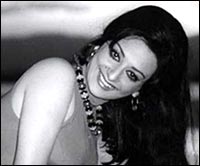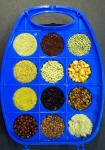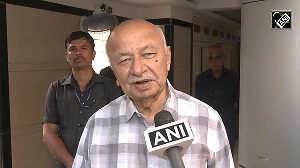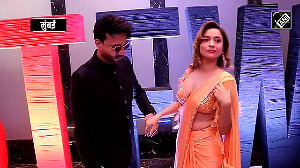Dinesh Raheja
Saira Banu was a fey beauty, as delicate as filigreed lace. But the painted talons she flashed on screen were also a symbol of her tenacity and spirit.
In a male-dominated film industry, Saira Banu was that rare actress who played heroine to Shammi Kapoor in Subodh Mukherjee's Junglee and, 14 years later, played his daughter in B R Chopra's Zameer.
Saira surmounted histrionic limitations, a gossiped-about illness and a much-married status to etch a long career as a glamour icon.
Gifted with an alabaster complexion, mahogany eyes (or was it lenses?), aquiline nose and an enviable figure, Saira thrived because her debut in Junglee (1961) coincided with the onset of the era of colour and Kashmir in Hindi films.
Though Saira had spent a significant part of her childhood in London and was a finishing school product, she fit the rustic beauty role in Junglee to a T. Cast as an innocent Kashmir ki kali who reduces the wild city cad Shammi Kapoor to a puddle of devotion, Saira exuded freshness and friskiness.
Filmalaya's Junglee created hysteria. Saira was considered a beauty queen for much of her career, but never again looked as breathtakingly beautiful as she did in Junglee.
|
Saira Banu's landmark films | ||
|
Year |
Film |
Costar |
|
1961 |
Junglee |
Shammi Kapoor |
|
1964 |
Ayee Milan Ki Bela |
Rajendra Kumar |
|
1967 |
Shagird |
Joy Mukherjee |
|
1968 |
Padosan |
Sunil Dutt |
|
1970 |
Gopi |
Dilip Kumar |
|
1970 |
Purab Aur Pascchim |
Manoj Kumar |
|
1972 |
Victoria No 203 |
Navin Nischol |
|
1974 |
Sagina |
Dilip Kumar |
|
1976 |
Hera Pheri |
Amitabh Bachchan |
Saira inherited her beauty from her mother, renowned 1940s actress Naseem Banu. Initially, filmmakers couldn't see beyond that. Saira was willing to learn (the novice dancer would keep a studio open at Filmalaya Studios to practise her dancing and became a proficient Kathak artiste).
But most of her 1960s films showed her either shrieking (who can forget the roof-shattering "You... farebi" from April Fool), simpering ("Samjhao apne dil ko" she whispers to an excited Rajendra Kumar while he drools Aaj ki raat yeh kaisi raat in Aman), or squealing (the famous Aiyaa from Shagird).
Aayee Milan Ki Bela (1964) witnessed both, the mehboob of the audience Rajendra Kumar, and the hunk-in the-making Dharmendra ardently wooing Saira. The film's success ensured that Saira and Rajendra teamed in three films in succession: Aman, Jhuk Gaya Aasman and K Asif's incomplete Sasta Khoon Mehnga Paani.
Those who linked her with the much-married Rajendra Kumar were silenced when Saira wed tragedy king Dilip Kumar (ironically, Rajendra Kumar's inspiration) in 1966. Saira willingly sublimated her single image for this May-December pairing, but did not stop acting in films.
Saira had starred regularly with Mukherjee scion Joy in many a clunker, but the 1967 hit Shagird proved a welcome wedding present. Playing a village Venus once again, Saira sported mini-saris that caught the fancy of the fashion-conscious though few had the courage to emulate her.
Always a fashion plate, Saira was forever encased in the pearl strings, chokers, mink stoles and mathapatti saris designed by mother Naseem.
By and large, Saira's performances had been like jelly --- they instantly melted in the mouth and were soon forgotten. But she showed a surprising flair for light-hearted drama in Shagird (her electric comic interactions with I S Johar and Joy saw her bagging a Best Actress nomination), and Padosan (1968). Padosan, in fact, was a family favourite. Her grandmother viewed it each time she wanted a mood elevator.
But success chose to play hide and seek with Saira through much of her career. The late 1960s saw the industry being flooded with rumours of Saira being seriously affected by a serious blood disease (it was actually a severe case of colitis).
|
Saira Banu's famous songs | ||
|
Song |
Film |
Singer |
|
Kashmir ki kali hoon main |
Junglee |
Lata Mangeshkar |
|
Tumhein pyar karte hai karte rahenge |
April Fool |
Suman Kalyanpur, Mohammed Rafi |
|
Tumhein aur kya doon main |
Ayee Milan Ki Bela |
Lata Mangeshkar |
|
Aiyya ... dil wil pyar vyar |
Shagird |
Lata Mangeshkar |
|
Unse mili nazar |
Jhuk Gaya Aasmaan |
Lata Mangeshkar |
|
Main chali main chali |
Padosan |
Lata Mangeshkar |
|
Neele parbaton ki dhara |
Aadmi Aur Insaan |
Asha Bhosle, Mahendra Kapoor |
|
Thodasa thehro |
Victoria No 203 |
Lata Mangeshkar |
|
Tumre sang toh rain bitayi |
Sagina |
Lata Mangeshkar, Kishore Kumar |
|
Chhotisi umar mein lag gaya rog |
Bairaag |
Lata Mangeshkar |
She had to take a break and lost out on many films including Chhoti Bahu with reigning superstar Rajesh Khanna.
The silver lining to the dark clouds was provided by Manoj Kumar. Ignoring all advice, he decided to play the waiting game for Saira to recover. He cast her as the smoking, drinking, miniskirt flaunting Indian girl in Purab Aur Paschim. The film's success accentuated Saira's Westernised image.
In the rollicking comedy Victoria No 203 (1972) she may have spent some screen time posing as a man. But there was no mistaking her identity when she wore two towels and tantalised Ranjeet in the sensual Thodasa thehro.
When Sharmila Tagore, Zeenat Aman and Parveen Babi flaunted their sexuality, Saira (who had been bold right from her Mera naam Rita Christina days in April Fool), became the first from the Asha Parekh-Nanda-Sadhana brigade to adapt to the times. Her daring decolletage made her rivals rush to their tailors (designers had still to enter the fray, full-time).
Her contemporaries Asha Parekh and Sadhana may have shone in the 1960s but by 1972, their halos were dimming. Saira was still a saleable star. The 1970s saw the release of over half a dozen films costarring her with Dharmendra (Aadmi Aur Insaan, Resham Ki Dori, Saazish, Chaitali, International Crook, Jwar Bhata, Pocketmaar).
Most of these films didn't line the pockets of the distributors but that didn't deter Dharmendra from working with her repeatedly.
This was Saira's most fecund phase. She had seven releases in 1974 and did two films (Zameer and Hera Pheri) with Amitabh Bachchan too.
Ever since her marriage to Dilip Kumar, Saira looked for roles with a dramatic centre. Her valiant attempts to establish a reputation as an actress after Gopi, Sagina and Bairaag (all with Dilip Kumar), and films like Hrishikesh Mukherjee's Chaitali met with limited success.
In 1976, Saira chose to draw the curtains on her career.
Subsequently, she has weathered a storm in her marriage, essayed a cameo opposite her husband in Duniya (1984); become a successful television producer but has primarily concentrated on being Mrs Dilip Kumar.







 © 2025
© 2025